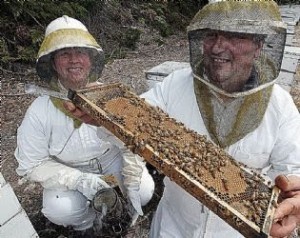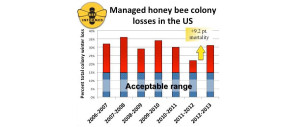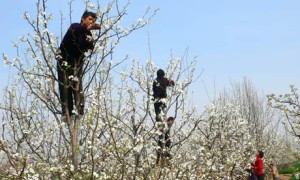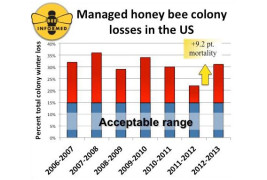Scott P. Roberts
The honey bee is just one of the many kinds of bees endemic to Florida. However, it is the most important bee to Florida agriculture and to that of the United States as a whole. The honey bee is credited with approximately 85% of the pollinating activity necessary to supply about one-third of the nation’s food supply. Well over 50 major crops are either dependent on these insects for pollination or produce more abundantly when honey bees are plentiful.[1]
I was really happy to see honey bees in the garden this year, especially over in the watermelon and squash. There were only a few, though. Nothing like when lawns had clover and clover had honey bees enough to make you watch your step.
 Bees are the only pollinators of watermelon and squash—and alfalfa, apple, apricot, blackberry, blueberry, cherry, sweet clovers, cranberry, cucumber, cantaloupe, nectarine, peach, pear, persimmon, plum, pumpkin, raspberry, and sunflower. They improve the yield and quality of eggplant, grape, lima bean, okra, pepper, soybean and strawberry.[2]
Bees are the only pollinators of watermelon and squash—and alfalfa, apple, apricot, blackberry, blueberry, cherry, sweet clovers, cranberry, cucumber, cantaloupe, nectarine, peach, pear, persimmon, plum, pumpkin, raspberry, and sunflower. They improve the yield and quality of eggplant, grape, lima bean, okra, pepper, soybean and strawberry.[2]
Bees are not the only pollinators of citrus, but they are the best. The citrus flower is normally botanically perfect, so self-pollination can occur when pollen sheds off the anthers and is caught on the sticky surface of the stigma. In addition, most citrus varieties have some level of parthenocarpy, the ability to develop (seedless) fruit without pollination.[3] But a great many varieties of citrus require cross pollination and the use of honey bees, in particular, remains the most consistent, effective and economical means of ensuring the pollination of citrus at the highest yields.[4]
So, bees are the best of all pollinators, and honey bees are the best pollinators of all bees. The size of their bodies allows them to fit into an enormous variety of flowers. Their larvae require a great deal of food,[5] so one healthy colony will send out thousands, even tens of thousands of workers to labor over an entire field or grove of plants of the same species, ensuring broad pollination. And then of course there is the fact that our good relationship with the honey bee allows us to move them to groves and fields where we need them[6] and, for nearly 3,000 years now, to collect the sweetest of benefits:
Given that there are few feral bees left in the U.S.,[7] we are deeply fortunate to have the domesticated honey bee. Essential to the nation’s food supply, to Florida agriculture and to the Florida economy, the honey bee is a state and national treasure. How troubling, therefore, the current predicament.
II
On May 2, 2013 the Bee Informed Partnership, in collaboration with the Apiary Inspectors of America (AIA) and the USDA, released a preliminary analysis of its seventh annual national survey of honey bee colony losses in the United States. It was a study of such losses during winter 2012-2013:
Preliminary survey results indicate that 31.1% of managed honey bee colonies in the United States were lost during the 2012/2013 winter. This represents an increase in loss of 9.2 points or 42% over the previous 2011/2012 winter’s total losses that were estimated at 21.9%. This level of loss is on par with the 6 year average total loss of 30.5%…Survey participants indicated that they considered a loss rate of 15% as “acceptable,” but 70% of them suffered losses greater than this.[8]
 Bee Informed also provided a graph of the survey year-to-year total colony winter loss percentages, beginning with winter 2006-2007:
Bee Informed also provided a graph of the survey year-to-year total colony winter loss percentages, beginning with winter 2006-2007:
During the same week this survey was released, the USDA and the U.S. Environmental Protection Agency delivered a summary of the proceedings of a stakeholder conference held October 15-17, 2012 in Alexandria, Virginia.[9] When one turns to the summary of the research presentation on the current state of knowledge of honey bee colony loss and its relation to honey bee health, one finds a very clear accounting of the predicament:
- Healthy honey bee colonies are critical for meeting the demands of food production in the United States.
- Currently, the survivorship of honey bee colonies is too low for us to be confident in our ability to meet the pollination demands of U.S. agricultural crops.
- Historically, the U.S. had as many as 6 million colonies in 1947, with declines since that time to about 4million in 1970 and 3 million in 1990. Today’s [10/2012] colony strength is about 2.5 million.
- Pollination demands have increased in recent years such that a single crop, almonds in California, now requires over 60 percent of all managed colonies.
- Honey bee colonies have been dying at a rate of about 30 percent per year over the past few winters which leaves virtually no cushion of bees for pollination.
- Because of the early almond pollination requirement, a 30 percent loss of the 2.5 million colonies would leave only 1.75 million colonies to meet the 1.5 to 1.7 million colonies currently needed in almonds. This situation leaves growers in a precarious position, and Dr. Pettis [Dr. Jeff Pettis, USDA ARS, Beltsville, Maryland] stated, “We are one poor weather event or high winter bee loss away from a pollination disaster.[10]
As we learned from Bee Informed, the U.S. loss for winter 2012-2013 was in fact high at 31.1% of the total number of colonies, and this did make the February, 2013 almond pollination difficult:
There was a shortage of honey bees this spring, reports University of California statewide apicurist Eric Mussen. “We did not have adequate numbers of grower-desired strong honey bee colonies (with eight frames or more) to meet the need.” To make up for the bee supply deficiency, beekeepers brought in lesser-sized colonies at the last minute. “Here we are with another good crop,” Mussen said. “If we had not acquired the smaller colonies we would have been short.[11]
These studies from the research community, reports from the federal government, and stories from the field have generated thousands of articles in the press. A recent one from Fox News tells Americans:
We’re serious folks — the foods that make America great are at stake here. Not just fancy-schmancy chef food, but all-time greats like cranberry sauce, peach cobbler, and apple pie. And the continued decline in bee populations would lead to the continued increase in world food prices.[12]
III
What is the cause of this dramatic loss of honey bee colonies? Let’s begin with some basic facts. First, this loss of bee colonies had a particular, recent beginning:
One day in November 2006—November 12, to be specific—Dave Hackenberg…went to move 400 hives he had left on a gravel lot south of Tampa, Florida, and found 360 of them oddly empty.[13]
Second, the scope of this worldwide loss since 2006 is unprecedented:
Although some losses of honey bees from healthy and well managed hives during the winter months have always been part of apiculture (for instance, in the New England area, winter losses of honey bee hives are typically15-30%), never in the history of the beekeeping industry has the loss of honey bee hives occurred in such magnitude and over such a widely distributed geographic area.[14]
And third, this loss has presented particular symptoms across all dead bee colonies. The symptoms and their appearance are reflected in the name given to the loss—Colony Collapse Disorder (CCD):
The main symptom of CCD is very low or no adult honey bees present in the hive but with a live queen and no dead honey bee bodies present. Often there is still honey in the hive, and immature bees (brood) are present.[15]
So as they have tried to determine the cause of CCD, researchers and beekeepers have started with these facts. Oh, and there’s one other fact: there were a very few bee bodies left to study from Dave Hackenberg’s hives. When Penn State entomologist Diana Cox-Foster conducted a molecular analysis of them she found:
…surprising levels of viral infections of various known types. But no single pathogen found in the insects could explain the scale of the disappearance…In other words, the bees were all sick, but each colony seemed to suffer from a different combination of diseases. We hypothesized that something had compromised the bees’ immune system, making them susceptible to any number of infections that healthy colonies would normally fend off. And Hackenberg was right: the prime suspects, varroa mites, were not present in numbers significant enough to explain the sudden die-off.[16]
That was 2006, and much research has been performed since then. What, today, is the prevailing opinion as to the cause of CCD? It is unchanged since it was first reported in the 2012 stakeholder conference summary:
- Research into CCD and poor colony health has been unable to identify a unique causative agent but consensus is building that a complex set of stressors and pathogens can result in colony losses.
- Factors that can lead to poor health include disease and arthropod pests, pesticides, poor nutrition and beekeeping practices.
This prevailing opinion of stakeholders is at best dissatisfying. At worst, given that there is so much, well, at stake, for the agricultural and chemical companies among the stakeholders, one can’t help but suspect that the opinion exists to ensure that no one can claim to have found a single cause, or blame a single interest.[17]
A number of researchers and beekeepers have rejected the prevailing opinion and argued for a single, overarching cause of CCD. Most visible among them are Professor Chensheng (Alex) Lu of Harvard University and Dave Hackenberg, the first beekeeper to observe and report CCD. Both believe that the relatively new neonicotinoid pesticides are to blame, and they’ve written and spoken persuasively in defense of this view.[18] But it’s also true that even Lu and Hackenberg see additional stressors as important pieces of the story. For Lu, it is critical that beekeepers switched to feeding their bees high fructose corn syrup—which, he believes, was spiked with high neonicotinoid loads—at about the time that CCD began to rage.[19] For Hackenberg, in addition to neonicotinoids, lack of bee pasture and loss of diverse pollen sources has played a big role.[20] Also working against neonicotinoid theory is the fact, made clear in one of the most recent field studies, that non-neonicotinoid fungicide and “old school” pyrethroid miticide loads in honey bees are increasing their susceptibility to infection.[21]
I too believe there is an overarching cause of CCD. To begin to get at what it is, consider this marvelous if disconcerting passage from The Beekeeper’s Lament, in which Hannah Nordhaus describes the pollination of the California almond crop. Sixty percent of all U.S. honey bees participate in this yearly event:
In the wild, one would expect to find three to four [bee] colonies per square mile; in the prelude to the almond bloom, apiarists must often stack thousands of hives in tenement-like holding yards. Some beekeepers must keep 2,000 hives in one spot, their bees competing with millions of others for what meager wild forage exists, subsisting on syrup and pollen patties and engaging in periodic inter-hive death matches. If the [almond] bloom comes late, the situation is even more precarious—a delayed bloom in 2007 coincided with the initial onslaught of CCD deaths. And even when the trees finally flower, it is crowded. A healthy hive can typically pollinate about an acre; but with two or even three hives per acre in the orchards, these arrangements bear far less resemblance to wild meadows than to feedlots for cattle or swine. And then of course there’s the danger of contagion—the fact that, for that six-week period when nearly every commercial hive in the country has been shipped to California, the Central Valley is essentially a single four-hundred-mile-long bee yard, with bees from Florida “swapping spit”…with others shipped from North Dakota, Arkansas, Pennsylvania, Texas…Each winter, pests and pathogens from one region hop with ease onto still-untainted bees from the rest of the country…And when beekeepers return home from the almond fields, they infect bees that have stayed at home with smaller-scale beekeepers, as well as whatever feral bees may have survived the previous season’s contagions. The almond orchards have been compared to a brothel for their remarkable capacity to transmit disease across the country; another apt metaphor might be a wartime military barracks, or a slave ship…[22]
Nordhaus’ intention in writing this passage was to get at the locus of the honey beekeeper’s sorrow:
It is, says…bee broker Pat Heitkam, a “Faustian bargain.”…The almond industry is killing John Miller’s bees [but]… in that first flourishing of spring, Miller’s bills get paid.[23]
But I think we can also find in Nordhaus’ work here, the trigger and even the broader cause of CCD, as well as the reason why it is so difficult for us to combat the disorder.
Circumstances at the 2007 California almond crop pollination conspired to trigger CCD. The vast majority of U.S. honey bees ride pollination circuits, and most of these circuits include the pollination of California’s almonds. That pollination event is always difficult on bee colonies for all the reasons Nordhaus describes, but in the winter of 2006-2007 it was made harder still by a later than normal almond bloom. For several weeks longer than “normal,” bees fought and survived on junk food—including acres and acres of pesticide-laden pollen—with no clean, diverse pollen sources in sight. This greatly compromised their health,[24] particularly their immune systems,[25] leading to “any number of infections that healthy colonies would fend off.”[26] In March 2007 the colonies left the California “brothel” and shared these illnesses with the rest of the nation’s bees at other stops along each of the circuits—the big citrus pollination in March and April, the apples in April and May, and so on. As the Bee Informed graph shows, 2007-2008 was the single highest honey bee colony loss yet recorded in the U.S.But if the trigger for CCD was the 2007 CA almond pollination, what is its broader cause? If we return to the factors that can lead to poor colony health in bees, above, we now understand that disease and pests come into play after, as Cox-Foster puts it, something (else) has compromised the bees’ immune system. From here, the broader cause comes into view when we ask of the remaining factors, “What makes sense of the fact that honey bees are today subject to high pesticide (insecticide, miticide, herbicide, and fungicide) loads, poor nutrition in the form of single source pollen and nectar, and beekeeper pollination circuits?” Well, the first two stressors are signature characteristics of today’s monocrop farming. The last stressor—the pollination circuit—is a beekeeping practice. But viewed more broadly, it is simply the most efficient way to insert the honey bee into today’s monocrop farming practice, including its cycles.
So the broader cause of CCD is fitting the honey bee into today’s factory efficient, monocrop way of farming. And now that the cause is clear, it is also clear why it’s so hard to combat the disorder. A great many of us are pleased with today’s farming practices, at least to the degree that we think about them. They pay beekeepers, farm, grove and orchard owners and farm hands, and others important to keeping the big crops coming,[27] and they deliver delicious almonds, oranges, apples—many of the most wonderful foods on Earth—to all the rest of us, all over the world, at reasonable prices. Doing things this way in California provides 80% of the entire world’s almond crop,[28] and similar methods and reasoning have led most of us to embrace factory farming of livestock.[29] So, why not factory farm the produce producing honey bee? This is progress…isn’t it?
 Well…did I mention CCD? This way of farming did produce a record crop of almonds in 2011 as well as a nice bump to the California economy. But the average yield per acre dipped in 2012, and has dipped further in 2013. Also in 2013, the average almond kernel weight was the lowest it’s been in 40 years[30] and, as noted earlier, the crop pollination was saved at the last minute by bringing in weak honey bee colonies. It would appear that this approach at this scale is not progress, at least because it’s not sustainable—not, anyway, with the honey bee in the starring role. But perhaps we could continue to produce nut and fruit crops in this way, at this size and pace, without the honey bee. Here’s how the apple orchards in Sichuan, China are pollinated, now that all the bees are gone:
Well…did I mention CCD? This way of farming did produce a record crop of almonds in 2011 as well as a nice bump to the California economy. But the average yield per acre dipped in 2012, and has dipped further in 2013. Also in 2013, the average almond kernel weight was the lowest it’s been in 40 years[30] and, as noted earlier, the crop pollination was saved at the last minute by bringing in weak honey bee colonies. It would appear that this approach at this scale is not progress, at least because it’s not sustainable—not, anyway, with the honey bee in the starring role. But perhaps we could continue to produce nut and fruit crops in this way, at this size and pace, without the honey bee. Here’s how the apple orchards in Sichuan, China are pollinated, now that all the bees are gone:
We see this so often today, a boon to the economy built on an environmental bust, supported by a culture still claiming that nature is here merely to be bent to our interests. We have interests in almonds, apples, and honey: why is it harder and harder to bend nature to serve them? Maybe our relationship with nature needs to change. And maybe that change begins, right now, with a remake of our relationship with the honey bee.
IV
I took my niece and a nephew to the local park this week. It has a big playground, a basketball court, a nicely manicured lawn that serves as a small soccer field, a sand volleyball court, and four Sandhill crane regulars. But what caught my eye was a tuft of tiny flowers right next to the basketball court. It was a little patch of clover that had been missed by the keeper of the weed-kill.
The patch was no more than three feet by six inches, clover with the tiniest of purple flowers. And lighting on those tiny flowers was a honey bee. It was wonderful to see her there (all the worker bees are female), going about her business with that singular honey bee focus.
Now, this moment was an accident: I am sure the tuft of clover will be removed. But what if it were not? What if we grew more tufts of clean clover and wildflowers? We know that bees are made healthy by feeding on diverse pollen and nectar sources. And thanks to a recent study,[31] we also know that honey bees will often completely bypass monocrops to feed on weeds and wildflowers if they are within three miles of the hive,[32] even if the weeds have similar pesticide loads. What if we once again made more pesticide-free clover and wildflowers available to the honey bee, and meadows, pastures, and woodlands? Some people have already begun to move in this direction.
These days Dave Hackenberg likes to point out the difference between “Ag and non-Ag bees,” between:
…bees that sat around in agriculture last summer, in corn, soybeans, and cotton, or pollinated crops on the east coast, [and] bees that went off to the woods someplace after they left California [almonds]…some guy had enough places that he could put them in the woods and make a little bit of honey and sustain them for the rest of the year, and then brought them back to California [for the almond pollination].[33]
He then shows some pictures of these non-Ag bees arriving in California, bees that:
…had been runnin’ in the mountains of Utah last summer instead of pollinating Ag crops…Hackenberg says, “This is the way I remember bees looking when I was a young guy…look at how many bees are in the air, and look at the vigor with which they’re flying. If you don’t have vigor like this, then you don’t have bees going to the trees.[34]
Hackenberg and other beekeepers are beginning to give their bees more time away from the pollination circuit, taking them where they can get healthy again, and then putting them back on the circuit with more honey in their hives and less corn syrup and pollen patties.
And, YOU can help honey bees get healthy again, too. How? One of the leading honey bee researchers—a colleague of Diana Cox-Foster’s named Dennis vanEngelsdorp—encourages everyone he meets to Make Meadows:
I’m glad to say that we know the cause of all these conditions. And that cause is NDD, Nature Deficit Disorder. And that is, that I think that, what we have in our society, is that we’ve forgotten our connection with nature, and I think that if we reconnect to nature, we’ll be able to have the resources and the interest to solve these problems. And I think that there is an easy cure for NDD, and that is, make meadows, not lawns…Now, not all of us have meadows, or lawns that we can convert, and so you can always, of course, grow a meadow in a pot…[35]
 Won’t you make a clean meadow in a pot, or maybe two, or three? The honey bees will come, and maybe with our meadows in pots, and with Dave Hackenberg and other beekeepers taking their honey bees to the woods and the mountains, we can give honey bees back their vigorous lives.
Won’t you make a clean meadow in a pot, or maybe two, or three? The honey bees will come, and maybe with our meadows in pots, and with Dave Hackenberg and other beekeepers taking their honey bees to the woods and the mountains, we can give honey bees back their vigorous lives.
But if bending to the interests of big Ag, big Chem and big (tract) Housing is still too much for the honey bee, then here’s another recommendation. Remember that honey bees choose weed and wildflower nectar and pollen over most crop pollens. Remember that this is true even when the weeds and wildflowers have pesticide levels equal to the levels in the crops.[36] Know that almond nectar is bitter to bees and humans (that’s why you don’t find almond honey on grocery store shelves); so bees would surely choose the nectar and pollen of, say, a clean meadow, over the nectar and pollen of almond crops, or corn for that matter, and of course over the pollen desert that is today’s lawn. Fourth, unlike a pig or a cow or a chicken, a honey bee is free to leave her enclosure and fly wherever she will. And if there’s a clean meadow within three miles, or even a “dirty” one, that’s where she’ll go.
Fifth and finally, I note that Meadows Are Movable: they fit neatly in truck beds and on flat beds and can be moved to where they’re needed, perhaps by the thousands to the California almond groves, to sit inside and beside and all around them:
Perhaps we should also move ten thousand meadows to the Dakotas and another ten to the Midwest, where small farms have given way to industrial farms, and where “unfortunately, corn has taken over and without bee pasture there’s really no place to go and keep these bees…”[37]
And we could move thousands more along both coasts, to where fields and woodlands have been beaten and sprayed into enormous housing communities with their monoculture, pesticide-laden crop: the perfect lawn.
Wherever we place our meadows, we know the bees will leave the monocrops and come to us. And we’ll again see many healthy honey bees in the air, flying with vigor. And this may be enough to save the honey bee for now, this civil resistance to the ways of big Ag, big Chem and big House, until we remake the Bigs to fit within our new culture, our new relationship with the whole of nature, including honey bees, in which we are no longer the conqueror, but instead a:
…member and citizen of it…[with] respect for…fellow-members, and also respect for the community as such. In human history, we have learned that the conqueror role is eventually self-defeating because it is implicit in such a role that the conqueror knows…just what and who is valuable, and what and who is worthless in community life. It always turns out that [the conqueror] knows neither…[38]
Colony Collapse Disorder is a colossal blunder, a perfect example of the conqueror not knowing what and who is valuable. And it’s not the Bigs’ first or only one.[39] So we have very good reason for our resistance. As beekeepers take hives off the circuit and into the mountains and woods, and the rest of us make and move meadows, we return honey bees to health by renewing that other, nearly 3,000 year relationship between humans and bees, the one that allows us both to flourish. With this Bigs blunder in fresh view we see with fresh eyes, that we can extend the older, wiser relationship and flourish as an entire nature-community. Maybe it’s not too late if take the first step, right now. Between the honey bee and the Bigs, right now, let’s choose the bee.
[su_divider top=”no”]
[1] Malcolm T. Stanford, Protecting Honey bees from Pesticides, http://edis.ifas.ufl.edu/aa145. Original publication date April 1993. Revised May 2003. Reviewed by Jamie Ellis September 2011, Institute of Food and Agricultural Sciences, University of Florida.
[2] http://www.aces.uiuc.edu/vista/html_pubs/BEEKEEP/CHAPT8/chapt8.html
[3] Pollination requirement and seeds in citrus, http://www.walterreeves.com/food-gardening/pollination-requirement-and-seeds-in-citrus/ 2011
[4] Malcolm T. Stanford, Pollination of Citrus by Honey Bees, http://edis.ifas.ufl.edu/pdffiles/AA/AA09200.pdf. Original publication date December 1992. Revised May 2003. Reviewed by Jamie Ellis, September 2011, Institute of Food and Agricultural Sciences, University of Florida.
[5] Spivak, M et al. 2011 Environ. Sci. Technol.: “Rich in protein, the pollen of many plant species serves as the principle food source for developing bee larvae.”
[6] But see Pettis, J et al. 2013 PLOSone, which suggests that honey bees sometimes don’t touch the crops we move them to when there are other more inviting sources of pollen and nectar nearby.
[7] Discover Magazine, 2013, http://blogs.discovermagazine.com/crux/2013/05/07/whats-behind-bee-die-off-u-s-and-europe-disagree/#.UjjkDT935x0
[8] http://beeinformed.org/2013/05/winter-loss-survey-2012-2013/
[9] http://www.usda.gov/documents/ReportHoneyBeeHealth.pdf, “Report on the National Stakeholders Conference on Honey Bee Health.” In the report, “stakeholders” is defined as beekeepers, scientists from industry/academia/government, representatives of conservation groups, beekeeping supply manufacturers, commodity groups, pesticide manufacturers, and government representatives
[12] http://www.foxnews.com/leisure/2012/07/19/crops-that-would-disappear-without-bees/
[13] Nordhaus, Hannah, The Beekeeper’s Lament, 2011 Harper Perennial
[14] Lu, C et al, 2012, Bulletin of Insectology
[15] http://www.ars.usda.gov/News/docs.htm?docid=15572 Honey Bees and Colony Collapse Disorder
[16] Cox-Foster, D et al, 2009, Scientific American
[17] On this point watch Dave Hackenberg’s presentation on YouTube, where he characterizes the “ChemAg companies” as trying to delay action on pesticides and fungicides for one year, then another, then another. http://www.youtube.com/watch?v=MyOanJ_bifo
[18] C. Lu, Ibid. Dave Hackenberg is in a great number of the news stories on CCD. See also his presentation on YouTube at http://www.youtube.com/watch?v=MyOanJ_bifo.
[19] C. Lu, Ibid.
[20] See Hackenberg’s YouTube presentation, Ibid., at about 22:37
[21] J.Pettis, et.al., 2013, Ibid. Whether or not they are the cause of CCD, there are many reasons to be concerned about neonicotinoid pesticides. Most important, they are one of what are called “systemic pesticides.” For an interesting introduction to systemic pesticides within the context of CCD, go to http://www.newyorker.com/online/blogs/comment/2012/04/new-studies-colony-collapse-disorder.html
[22] Nordhaus, Hannah, Ibid.
[23] Nordhaus, Hannah, Ibid.
[24] C. Alaux, et al., Diet effects on honeybee immunocompetence, Biology Letters 2010; and Kathleen M. Prough – Chief Apiary Inspector Indiana Department of Natural Resources, http://www.in.gov/dnr/entomolo/files/ep-Gardening_for_Honey_Bees.pdf : “Select plants that will provide pollen as well as nectar. Bees need diverse pollen and nectar sources for balanced diet.”
[25] Higes, M et al., 2008 Environmental Microbiology; J. Pettis et al, 2012, Naturwissenschaften; C. Lu, 2012, Ibid; J. Pettis, 2013, Ibid.
[26] D. Cox-Foster, Ibid.
[27]Including pesticide and GMO crop companies. To read about an interesting recent GMO development in Tampa, go to http://www.wfla.com/story/23264718/clearwater-grocery-store-has-gmo-researcher
[28] http://www.agmrc.org/commodities__products/nuts/almond-profile/
[29] See, for example, Alastair Norcross, Puppies, Pigs and People: Eating Meat and Marginal Cases, and Roger Scruton, Eating Our Friends.
[31] J.Pettis, 2013, Ibid.
[32] Dave Hackenberg’s number for how far in all directions from the hive, worker honey bees search.
[33] Dave Hackenberg’s presentation on YouTube, Ibid.
[34] Dave Hackenberg’s presentation on YouTube, Ibid.
[36] J. Pettis, Ibid.
[37] Dave Hackenberg’s presentation on YouTube, Ibid at about 22:37.
[38] Aldo Leopold, The Land Ethic.
[39] For example, see my “Waking Up to the Demise of the Indian River Estuary,” Ecology Florida, www.ecologyflorida.org.
[su_box title=”Meet the Author” style=”soft” box_color=”#e6f5e3″ title_color=”#000000″]Scott P. Roberts is an adjunct ethics professor, gardener and writer living in Odessa, Florida. Earlier in life he was a researcher in ethics and computing at Carnegie Mellon University and director of Annenberg Media (now Annenberg Learner) in Washington, D.C.[/su_box]


Comments
One response to “FEATURE: Make Meadows Not Lawns for Honey Bee Colony Health”
[…] http://www.ecologyflorida.org/2013/12/feature-make-meadows-not-lawns-for-honey-bee-colony-health/ […]